Unveiling the Mysteries of the Sagitta Constellation
Have you ever gazed up at the night sky and wondered about the secrets it holds? One such enigma is the Sagitta constellation, a celestial formation that has intrigued astronomers and mythologists for centuries. With its distinct shape resembling an arrow, Sagitta has captivated our imaginations and sparked numerous tales and interpretations. In this article, we embark on a journey to unravel the mysteries surrounding this fascinating constellation. We will delve into its origin, explore its symbolic meanings, uncover hidden secrets, and discover why Sagitta continues to leave a lasting legacy in the realms of art, literature, and astrology. So, let’s peer through the cosmic veil and discover the captivating story of Sagitta.
Contents
- The Origin of the Sagitta Constellation
- The Arrow of Orion
- The Symbolism of the Sagitta Constellation
- Unveiling Hidden Secrets
- Exploring the Sagitta Constellation Today
- The Legacy of Sagitta
- Conclusion
-
Frequently Asked Questions
- FAQs About the Sagitta Constellation
- 2. Can the Sagitta constellation be seen from both hemispheres?
- 3. Are there any notable stars within the Sagitta constellation?
- 4. Is Sagitta part of any larger constellation group?
- 5. Can the Sagitta constellation be seen with the naked eye?
- 6. Are there any deep-sky objects within Sagitta?
- 7. Does Sagitta have any cultural significance outside of Greek mythology? References Sagitta Constellation (the Arrow): Stars, Myth, Facts…
-
Frequently Asked Questions
- 1. What is the significance of the Sagitta constellation in ancient mythology?
- 2. How did ancient astronomers observe and track the Sagitta constellation?
- 3. Is there any connection between the Sagitta constellation and the well-known Orion constellation?
- 4. What symbolism is associated with the Sagitta constellation?
- 5. Are there any specific astrological meanings linked to the Sagitta constellation?
- 6. Are there any lost artifacts or historical references associated with the Sagitta constellation?
- 7. What are some notable celestial objects within the Sagitta constellation?
- 8. How can I observe the Sagitta constellation in the night sky?
- 9. How has the Sagitta constellation influenced literature and art throughout history?
- 10. Does the Sagitta constellation hold any significance in modern astrological interpretations?
- References
- Read More
The Origin of the Sagitta Constellation
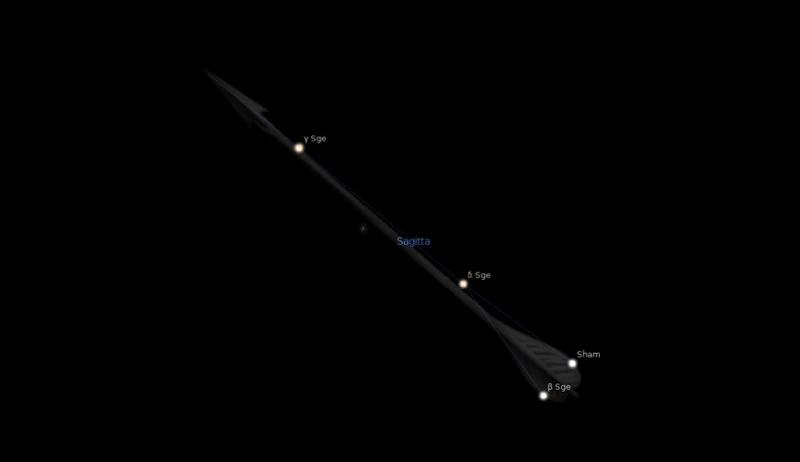
The Origin of the Sagitta Constellation
In ancient mythology, the story of Sagitta traces back to the tale of the Greek hero, Heracles. Legend has it that during his epic battle with the monstrous nine-headed Hydra, Heracles aimed his bow towards the creature to defeat it. As he shot his arrow, the gods intervened, instructing Zeus’ eagle to snatch the arrow in mid-air and place it among the stars. Thus, the arrow became the Sagitta constellation, forever immortalized in the night sky as a symbol of Heracles’ heroic triumph and divine assistance.
Long before the emergence of written records, ancient civilizations were already observing and studying the stars. The Sagitta constellation was cataloged by the renowned Greek astronomer Ptolemy in his Almagest, a comprehensive compilation of astronomical knowledge during the 2nd century. Interestingly, although Ptolemy acknowledged the existence of Sagitta, he did not attribute any specific story or myth to the constellation. This suggests that the origin and meaning of Sagitta may predate even ancient Greek mythology, remaining a mystery lost to time and forgotten civilizations. Nevertheless, its symbolic shape and alignment continue to captivate stargazers and inspire wonder to this day.
When exploring the connection between astrology and constellations like Sagitta, it’s fascinating to see how certain zodiac signs and celestial objects play a role in pop culture. Celebrities and well-known figures often align themselves with specific zodiac signs, embracing the belief that astrological influences shape their personalities and destinies. From musicians to actors, understanding how the stars and zodiac signs intertwine in popular culture sheds light on the ongoing fascination with astrology and its links to the celestial realm.
1.1 The Mythological Background
1.1 The Mythological Background
In Greek mythology, the Sagitta constellation is linked to the heroic tale of Heracles, known as Hercules in Roman mythology. According to the myth, Heracles was a demigod, the son of Zeus, the king of the gods, and Alcmene, a mortal woman. Heracles was renowned for his incredible strength and his twelve labors, tasks given to him as punishment for killing his wife and children in a state of madness induced by the goddess Hera.
During one of these labors, Heracles faced the formidable Hydra, a serpent-like creature with multiple heads that grew back when severed. As the battle raged on, Heracles managed to decapitate the Hydra, but every time he did, two new heads would sprout in its place. Realizing he needed assistance, Heracles sought the help of his nephew, Iolaus. Together, they developed a clever strategy. As Heracles cut off the Hydra’s heads, Iolaus cauterized the necks to prevent new growth. With their combined efforts, they defeated the Hydra.
In recognition of their victory, Zeus sent his eagle to retrieve one of Heracles’ arrows, which had been imbued with the divine power of the gods. The eagle plucked the arrow from the battlefield and, in a graceful flight, placed it among the stars, forming the Sagitta constellation. This constellation serves as a perpetually visible symbol of Heracles’ bravery, his triumph over adversity, and the gods’ assistance in his heroic endeavors.
The mythology surrounding Sagitta not only adds to the richness of its story but also connects with the broader celestial narratives present in ancient cultures. The celestial events and formations were often attributed to the actions of gods and goddesses, intertwining the realms of mythology and astronomy. Exploring these mythological backgrounds helps us understand the intricate connections between human belief systems, the celestial sphere, and the enduring allure of constellations like Sagitta.
If interested in how ancient cultures viewed the stars and their impact on our lives, one can delve into the realm of astrology. Astrology, with its roots in ancient civilizations and diverse cultural belief systems, examines the influence of celestial bodies on human behavior and life events. Looking at astrology in pop culture and its associations with celebrities offers a modern lens through which we can understand the continuing fascination with celestial symbolism and the interconnectedness between the cosmic and human realms.
1.2 The Ancient Astronomical Observations
1.2 The Ancient Astronomical Observations
The ancient civilizations had a profound fascination with the stars, and their observations of the night sky played a crucial role in the development of astronomy. Many cultures, such as the Babylonians, Egyptians, and Greeks, meticulously recorded their astronomical findings, contributing to our understanding of celestial bodies, including the Sagitta constellation.
The Babylonians, known for their advanced understanding of mathematics and astronomy, made substantial contributions to the field. They curated detailed celestial catalogs, which included the Sagitta constellation. These catalogs, often engraved on clay tablets, provide valuable insights into the ancient perception and classification of the stars.
Similarly, the ancient Egyptians also documented their astronomical observations. Hieroglyphic texts found in the temple complexes of Dendera and Edfu depict celestial scenes, including the Sagitta constellation. These illustrations highlight the significance of the stars in their religious and cosmological beliefs.
The Greeks, renowned for their philosophical pursuits, further advanced the understanding of celestial bodies. Scholars like Hipparchus and Ptolemy meticulously studied the night sky, developing astronomical theories and models. Ptolemy’s Almagest, a comprehensive treatise on astronomy, not only cataloged various constellations but also provided valuable information about their positions and magnitudes. While not as detailed in mythological associations, Ptolemy’s work laid the foundation for our current knowledge of the Sagitta constellation.
The ancient astronomical observations of various civilizations provide a glimpse into the human fascination with the cosmos. These records showcase the commitment of these ancient scholars to unravel the mysteries of the universe, laying the groundwork for future generations of astronomers and scientists.
If you’re curious to explore more about how astrology intersects with popular culture, including the influence of zodiac signs on celebrities and well-known figures, you can delve into the fascinating realm of astrology in the world of pop culture. Understanding the prevalent fascination with astrology sheds light on the enduring connection between humanity and the stars.
The Arrow of Orion
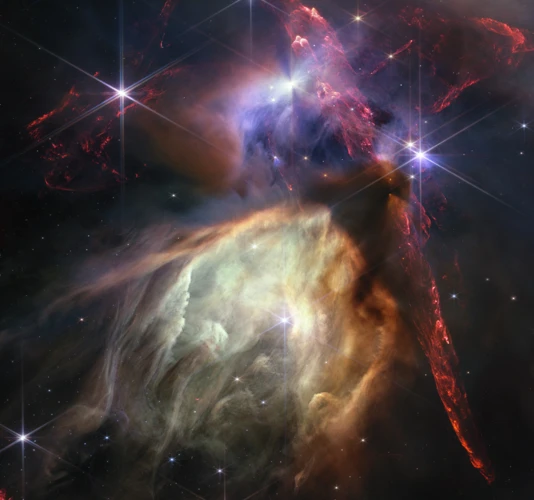
The Arrow of Orion
The Sagitta constellation holds a significant connection to another prominent constellation in the night sky: Orion. In Greek mythology, Orion was a mighty hunter and warrior. According to one myth, Orion was the son of Poseidon, the god of the sea, and was known for his exceptional hunting skills. During his time on Earth, Orion formed a close bond with the goddess Artemis, the goddess of the hunt. However, his arrogance and boastfulness eventually led to his downfall.
In a twist of fate, Orion was stung by a scorpion and died. Grief-stricken, Artemis begged Zeus to immortalize her beloved hunter in the night sky. Zeus granted her request and transformed Orion into a constellation, placing him in the heavens for eternity.
The connection between Orion and Sagitta lies in the story of Heracles. As mentioned earlier, it was Heracles who shot the arrow that became the Sagitta constellation. However, some interpretations suggest that the arrow may have a dual significance, representing not only the arrow shot by Heracles but also the arrow aimed by Artemis, which struck Orion.
In astrology and pop culture, the Orion constellation has also gained recognition for its association with the zodiac sign Gemini. Gemini, represented by the Twins, is symbolized by the duality and versatility often attributed to this constellation. This connection further emphasizes the interplay between celestial bodies and the influence they have on our lives and personalities.
The link between Sagitta, Orion, and astrology highlights the enduring fascination with the celestial realm. From ancient myths and legends to modern interpretations, the alignment of these constellations continues to captivate imaginations and spark curiosity about the cosmos and its connections to our human existence. Whether it’s through the lens of pop culture or the study of astrology, the Arrow of Orion remains a mesmerizing aspect of the night sky, inviting us to ponder the mysteries of the universe.
2.1 The Connection to Orion
2.1 The Connection to Orion
The Sagitta constellation holds a fascinating connection to one of the most prominent and recognizable constellations in the night sky – Orion. Orion, often depicted as a mighty hunter, stands prominently in the celestial sphere. Within Orion, lies an asterism known as Orion’s Belt – three bright stars that form a distinctive line. Interestingly, if you extend an imaginary line from the stars of Orion’s Belt towards the northeast, it leads directly to Sagitta. This alignment has led astronomers to forge a connection between these two celestial formations.
In mythology, Orion was a renowned hunter whose tale has been told in various cultures throughout history. According to Greek legend, Orion was the son of Poseidon and a mortal woman. His strength, agility, and courage made him a formidable hunter, and his adventures became the stuff of legends. Orion’s story became intertwined with the story of Artemis, the goddess of the hunt, who eventually placed him among the stars after his tragic demise.
The connection between Orion and Sagitta has sparked speculation and interpretation over the years. Some believe that the arrow of Sagitta represents the weapon used by Orion, further reinforcing the connection between the two constellations. Others see it as a symbolic gesture, signifying the passing of the torch from Orion’s heroic endeavors to the divine intervention represented by Sagitta. Whatever the interpretation may be, the link between Sagitta and Orion adds layers of depth and intrigue to the cosmic narrative, inviting us to ponder the intricate relationship between these celestial giants.
When exploring the connection between astrology and constellations like Sagitta, it’s fascinating to see how certain zodiac signs and celestial objects play a role in pop culture. Celebrities and well-known figures often align themselves with specific zodiac signs, embracing the belief that astrological influences shape their personalities and destinies. From musicians to actors, understanding how the stars and zodiac signs intertwine in popular culture sheds light on the ongoing fascination with astrology and its links to the celestial realm.
2.2 Mythological Significance
2.2 Mythological Significance
The Sagitta constellation holds significant mythological importance across various cultures. In Greek mythology, Sagitta is associated not only with Heracles but also with the god Apollo, who was known for his skill in archery. It is believed that Sagitta represents the arrow that Apollo used to conquer the fearsome Python, a creature that guarded the Oracle of Delphi. This connection solidifies the constellation’s role as a symbol of power, precision, and triumph in the face of formidable challenges.
In Hindu mythology, the Sagitta constellation takes on a different meaning. It is often associated with the divine weapon of Lord Rama, the hero of the epic Ramayana. Lord Rama’s bow, known as the Sharanga, was said to be adorned with golden feathers from a celestial bird, which provided its arrows with unmatched strength and precision. The Sagitta constellation is believed to represent both the sacred arrows and the celestial bird, embodying the divine intervention and protection bestowed upon Lord Rama in his quest to vanquish evil and restore balance to the world.
The mythological significance of Sagitta extends beyond these examples, with different cultures attributing diverse tales and deities to this enigmatic constellation. These stories highlight themes of bravery, celestial aid, and the triumph of good over evil. It is through these tales that we can appreciate the rich tapestry of mythology and its timeless influence on human understanding of the cosmos. To delve further into the connections between mythology and the stars, you may find it intriguing to explore the role of celestial alignments in history and the fascinating beliefs surrounding reincarnation in Hindu mythology. The interplay between mythology, astrology, and cultural significance weaves an intricate web that continues to captivate and inspire us today.
The Symbolism of the Sagitta Constellation
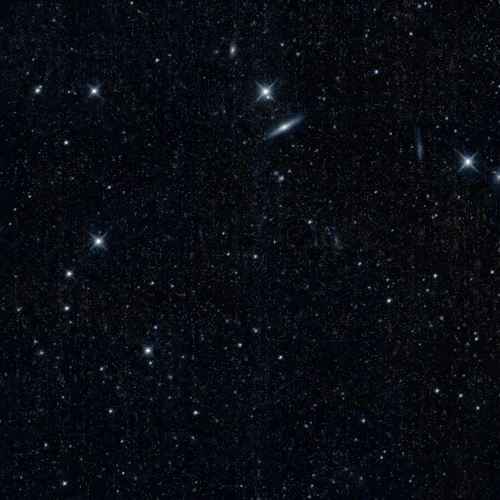
The Symbolism of the Sagitta Constellation
The Sagitta constellation holds deep symbolic significance across various cultures and belief systems. In many ancient civilizations, arrows were associated with divine intervention and protection. As such, Sagitta represents the idea of celestial assistance and the intervention of higher powers in the human realm. It serves as a reminder that even in the face of challenges and adversities, there is always the potential for assistance and guidance from higher forces.
Astrologically, Sagitta has been linked to the idea of moments of clarity and sudden insights. Just as an arrow swiftly pierces through the air, Sagitta is believed to bring sudden bursts of inspiration and illumination. Those born under the sign of Sagitta may possess an innate ability to perceive hidden truths and have a sharp sense of intuition. In astrology, the constellation can act as a catalyst for personal growth and the ability to navigate through life with purpose and direction.
While exploring the connections between astrology and popular culture, it’s interesting to see how the symbolism of Sagitta resonates with individuals and its portrayal in various art forms. From literature to visual arts, the Sagitta constellation has been featured as a symbol of hope, courage, and the pursuit of truth. Its representation in popular culture and its continued significance in astrological interpretations serve as a testament to the enduring fascination and influence that celestial bodies hold over human imagination.
Understanding the symbolism and meanings behind constellations like Sagitta allows us to delve deeper into the rich tapestry of human beliefs and experiences. The allure of the stars and our connection to the celestial realm have fascinated and inspired us for centuries. Whether we seek divine assistance, personal illumination, or simply a sense of wonder, the Sagitta constellation continues to hold an important place in our collective understanding of the mysteries of the universe.
3.1 Representing Divine Intervention
3.1 Representing Divine Intervention
The Sagitta constellation, with its arrow-like shape, has long been associated with the concept of divine intervention. In ancient mythology, the gods often intervened in the affairs of mortals, assisting them in moments of great need or providing guidance. The placement of the Sagitta constellation among the stars portrays this notion of divine intervention, as Heracles’ arrow is snatched by Zeus’ eagle before it reaches its target. This celestial act symbolizes the gods intervening to pave the way for ultimate triumph and success.
The concept of divine intervention resonates beyond mythology and finds its place in various religious and spiritual beliefs. Across different cultures, there is a prevailing belief that higher powers or spiritual beings can intercede in human experiences and alter the course of events. The arrow of Sagitta, suspended in the night sky, acts as a reminder of the possibility of unseen forces guiding and protecting us.
In the realm of astrology, the Sagitta constellation represents one of those celestial influences, a reminder of the universe’s intricate workings and the notion that we are not alone in our journey. Looking to the stars as a source of guidance and inspiration has been an integral part of human history, and Sagitta’s association with divine intervention adds an element of mystery and awe to the astrological tapestry. Exploring the connection between astrology and various aspects of our lives, such as pop culture and the fascination with zodiac signs, highlights the enduring belief in the celestial realm’s impact on our human existence./astrology-pop-culture-zodiac-celebrities/
3.2 Associated Astrological Meanings
Associated Astrological Meanings
In astrology, each constellation holds its own unique significance and influence on individual horoscopes. While Sagitta may not be one of the well-known zodiac constellations, it still carries astrological meaning for those born under its celestial influence. People born with Sagitta as their ruling constellation are believed to possess an inherent determination, symbolized by the arrow’s resolute aim towards its target. They are seen as individuals who have a keen sense of direction and unwavering focus when pursuing their goals. Sagitta’s association with Heracles’ arrow also highlights the potential for these individuals to receive divine guidance and intervention in their journeys.
Additionally, Sagitta’s placement in the night sky has been linked to the concept of transcendence and spiritual growth. Those influenced by this constellation are thought to possess a yearning for higher knowledge and understanding. They may find themselves drawn to esoteric subjects and philosophical pursuits, eager to explore the hidden depths of spirituality and the mysteries of the universe. This celestial influence can inspire a sense of purpose and a desire to make a difference in the world, using their arrow-like drive to propel themselves towards higher ideals and enlightenment.
It is important to note that astrology is a complex and multifaceted field of study, and interpretations can vary among different astrologers and cultures. To truly understand the astrological meanings associated with Sagitta, it is essential to delve into the rich history of planetary alignments and the beliefs of various cultures throughout time. Exploring the connections between astrology and Hindu mythology, for instance, highlights how celestial bodies have long held significance in different spiritual traditions, and how these beliefs have shaped our understanding of the cosmos and our place within it.
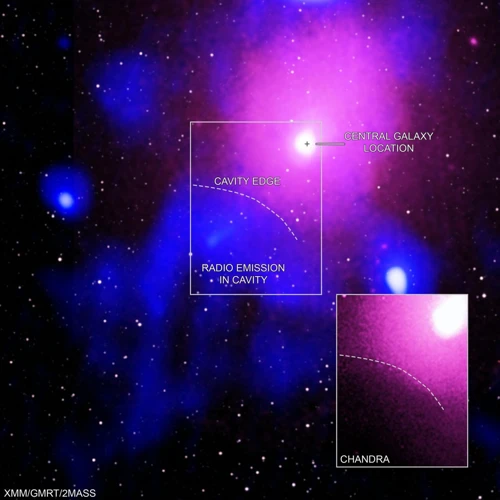
Unveiling Hidden Secrets
The Sagitta constellation has long been shrouded in mystery, with hidden secrets waiting to be discovered among its stars. One such intrigue lies in the search for lost constellation artifacts. Over the centuries, civilizations have created intricate depictions and representations of constellations, including Sagitta. However, as time passed, many of these artifacts were lost or destroyed. Archaeologists and historians have dedicated themselves to uncovering these ancient artifacts, hoping to shed light on the symbolism and significance associated with Sagitta and other constellations. While progress has been made in recovering and restoring some artifacts, many mysteries still remain, adding to the allure of the constellations and their hidden past.
In addition to the search for lost artifacts, modern astronomical discoveries continue to unveil new insights into the Sagitta constellation. The advancements in technology and space exploration have allowed scientists to delve deeper into the cosmos, revealing celestial objects and phenomena that were previously unknown. One notable discovery related to Sagitta is the identification of a young star system within the constellation. This finding has sparked interest and further investigation into the formation and evolution of stars within Sagitta and its neighboring constellations.
The study of planetary alignments throughout history has contributed to our understanding of the hidden secrets within constellations like Sagitta. Planetary alignments occur when multiple planets align in the same area of the sky, creating a unique celestial configuration. These alignments have been observed and recorded throughout different time periods, providing clues about the cultural and astronomical significance attached to specific constellations. By examining historical records and analyzing the alignments in relation to Sagitta, researchers have been able to decipher some of the hidden secrets encoded within the constellation’s mythological and astronomical legacy.
As we uncover the hidden secrets of Sagitta, the journey becomes not only one of scientific exploration but also a testament to the enduring intrigue and wonder of the cosmos. Whether through the search for lost artifacts, groundbreaking astronomical discoveries, or the revelation of planetary alignments, each revelation brings us closer to unraveling the enigmatic nature of Sagitta and the universe it resides in.
4.1 The Lost Constellation Artifacts
4.1 The Lost Constellation Artifacts
Throughout history, various civilizations have revered the stars and constellations, attributing them with profound significance. The Sagitta constellation is no exception, and over time, there have been tales of lost artifacts associated with this celestial arrow. These mythical objects allegedly possess mystical powers and bear a connection to the stars above.
One such artifact is the legendary “Arrow of Destiny,” which according to ancient lore, was said to be crafted from a fragment of the divine arrow that formed the Sagitta constellation. It was believed that whoever possessed this artifact would be granted immense power and guidance from the heavens. However, the whereabouts of this artifact remain unknown, lost to the passage of time and hidden among the annals of history.
Another lost artifact intertwined with Sagitta is the “Star Stone,” rumored to have fallen from the sky and landed on Earth thousands of years ago. This sacred stone was believed to contain the essence of the constellation itself, carrying its celestial energy within. Many adventurers and treasure hunters have embarked on quests to find this elusive artifact, seeking to harness its mystical powers for their own purposes.
While the existence of these lost constellation artifacts remains shrouded in mystery, they serve as a testament to the enduring fascination and reverence for celestial objects throughout human history. The stories and legends surrounding these artifacts add an air of enchantment and intrigue to the study of the Sagitta constellation and its significance in ancient cultures.
To further understand the historical context and significance of lost artifacts, it is crucial to explore the influence of planetary alignments on human beliefs and mythology. These alignments have been seen as powerful omens and celestial events that shape the course of human lives. By analyzing the historical significance and interpretations of planetary alignments, we gain valuable insights into how ancient civilizations perceived and interacted with the cosmos. From Greek mythology to Hindu narratives, the belief in reincarnation and the influence of celestial bodies offer a rich tapestry of connections to the secrets of the universe.
4.2 Modern Astronomical Discoveries
Modern Astronomical Discoveries
Advancements in technology and the field of astronomy have allowed scientists to explore the Sagitta constellation in greater detail. Through telescopes and advanced imaging techniques, astronomers have made fascinating discoveries about the stars and objects within Sagitta.
One notable discovery is the presence of a pulsar, a highly magnetized rotating neutron star, located within Sagitta. Pulsars emit regular pulses of electromagnetic radiation, resulting in a pulsating signal detectable from Earth. This pulsar, known as PSR B1929+10, was first identified in 1982 and has since provided valuable insights into the behavior and nature of such extreme celestial objects.
Astronomers have also identified several open star clusters within Sagitta. These clusters, composed of young stars born from the same molecular cloud, provide scientists with valuable data regarding stellar evolution and the formation of planetary systems. One well-known open cluster in Sagitta is M71, also referred to as the “Little Gem.”
These modern discoveries bring us closer to understanding the intricate workings and composition of the Sagitta constellation. By studying the stars, pulsars, and star clusters within Sagitta, astronomers continue to deepen our knowledge of the universe and unlock its hidden mysteries.
For more information on astronomical phenomena and their historical significance, refer to the extensive research on planetary alignments throughout history. These celestial events have influenced cultures and belief systems across various civilizations, leading to intriguing connections with mythology and even concepts like reincarnation found within Hindu mythology.
Exploring the Sagitta Constellation Today
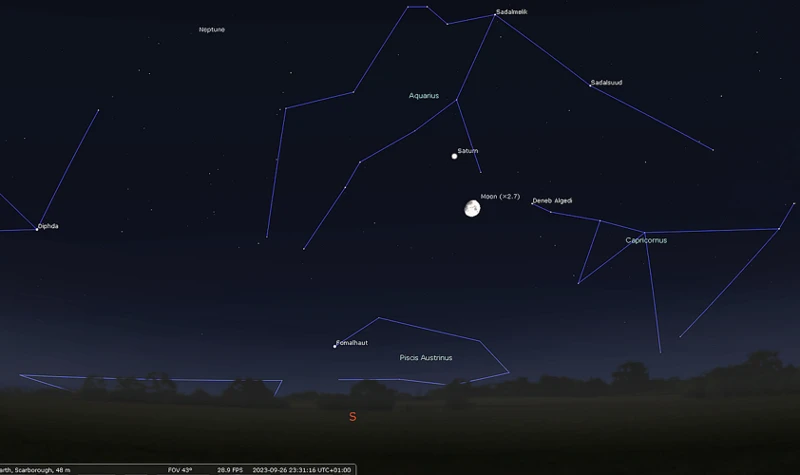
Exploring the Sagitta Constellation Today
To this day, enthusiasts and stargazers continue to be enchanted by the captivating sight of the Sagitta constellation in the night sky. With its distinct arrow-like shape, Sagitta is relatively easy to find, making it a popular target for amateur astronomers. The best time to observe Sagitta is during the summer months in the Northern Hemisphere, when it is most prominent in the northeastern portion of the sky.
One way to locate Sagitta is by first identifying the well-known constellation of Cygnus, also known as the Northern Cross. By drawing an imaginary line from the star Deneb, which marks the tail of Cygnus, towards the east, it will lead to the arrowhead of Sagitta. The constellation is made up of a line of stars that represent the shaft of the arrow, with the arrowhead at the end.
While Sagitta may not boast an abundance of notable celestial objects like other constellations, it is still worth exploring for its simplicity and historical significance. One interesting celestial object within Sagitta is the Sagitta Nebula, a small planetary nebula located near the arrowhead. Planetary nebulae are remnants of dying stars, and the Sagitta Nebula offers a unique glimpse into the final stages of stellar evolution.
As we gaze up at the night sky, it is worth reflecting on the vastness of our universe and the mysteries that lay within its constellations. The exploration of Sagitta serves as a reminder of our ancestral fascination with the stars and the beauty and wonder they hold. Whether it’s through the lens of astrology, mythological connections, or scientific curiosity, the Sagitta constellation continues to inspire and captivate those who dare to venture into the celestial realms.
To further delve into the history and significance of celestial observations, one may explore the fascinating topic of planetary alignments. These alignments have played a significant role in shaping our understanding of the cosmos throughout various cultures and civilizations. Additionally, exploring the connections between Hindu mythology and the concept of reincarnation can provide a deeper perspective on the celestial beliefs and traditions that have endured over centuries.
5.1 Observing Sagitta in the Night Sky
Observing Sagitta in the Night Sky
To catch a glimpse of the Sagitta constellation in the vast expanse of the night sky, star enthusiasts should look towards the northern hemisphere during the summer months. Sagitta is located in the region of the sky known as the Summer Triangle, along with the constellations Lyra and Aquila. The best time to observe Sagitta is during the months of July and August, when the Summer Triangle is at its highest point in the sky. Look for its distinctive shape, resembling an arrow pointed towards the beautiful blue-white star Vega in the constellation of Lyra. With a moderate brightness, Sagitta might require binoculars or a telescope to fully appreciate its intricate details and surrounding stars.
One notable feature within the Sagitta constellation is a small but prominent open star cluster named M71. Located about 13,000 light-years away from Earth, M71 is a relatively young cluster with a dense population of stars. It is certainly a sight to behold, especially when observing it with a telescope, allowing for a clearer glimpse of the magnificent cluster. Another celestial object within Sagitta is the planetary nebula named Abell 65. This breathtaking mass of glowing gas and dust is the remnant of a dying star. Its vibrant colors and intricate patterns make it a fascinating target for astronomers and astrophotographers alike.
Whether you are an amateur astronomer, an avid sky gazer, or simply someone who appreciates the celestial beauty above us, taking the time to observe Sagitta in the night sky can be a rewarding experience. So, find a clear night, grab a telescope or binoculars, and let the wonders of Sagitta unveil themselves before your eyes.
5.2 Notable Celestial Objects in Sagitta
Notable Celestial Objects in Sagitta
Within the boundaries of the Sagitta constellation, there are several fascinating celestial objects that have captured the interest and curiosity of astronomers and stargazers alike. One such object is the open star cluster known as Messier 71, or M71. Located approximately 13,000 light-years away from Earth, M71 is a densely packed cluster of stars that forms a distinct pattern within Sagitta. Observing this cluster through a telescope reveals a stunning arrangement of stars, each sparkling with its own individual brilliance.
Another prominent celestial object in Sagitta is the planetary nebula named PK 20+4.1, also known as the “Little Gem Nebula.” This nebula, situated around 7,000 light-years away, displays a captivating structure resembling a glowing gem set against the dark backdrop of space. Its intricate details, including delicate filaments and intricate patterns of light and color, make it a mesmerizing sight for astronomers.
Sagitta is also home to several variable stars that have captivated researchers. One notable example is the variable star U Sagittae, which undergoes periodic outbursts that cause its brightness to fluctuate dramatically. These outbursts are thought to be the result of interactions within a binary star system, making U Sagittae a subject of great interest and study.
Exploring these celestial objects within the Sagitta constellation allows astronomers to gain insights into stellar evolution, the dynamics of galaxies, and the intricate interplay of light and matter in the universe. Their beauty and significance serve as a reminder of the vastness and complexity of the cosmos, igniting a sense of wonder and awe in those who venture to explore the mysteries of Sagitta’s celestial treasures.
The Legacy of Sagitta
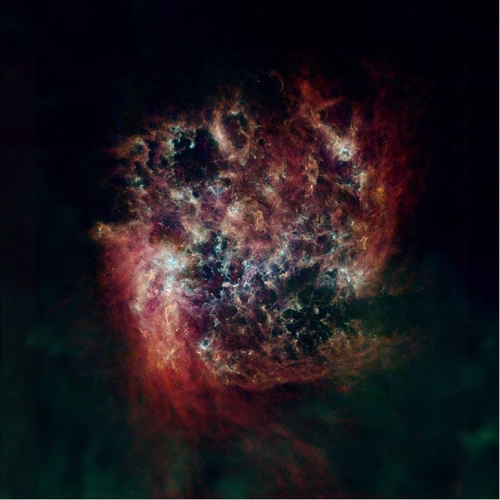
The Legacy of Sagitta
The legacy of the Sagitta constellation extends far beyond its mythological origins and astronomical significance. Throughout history, Sagitta has left an indelible mark on various aspects of human culture, particularly in the realms of literature and art.
In literature, Sagitta has been featured and referenced in numerous works of fiction, poetry, and mythology. Its association with Heracles and his heroic triumph over the Hydra has inspired writers to incorporate Sagitta as a symbol of victory, determination, and divine intervention. Sagitta’s arrow serves as a metaphor for overcoming obstacles and achieving greatness, providing literary characters with a sense of purpose and destiny.
In art, Sagitta has also been a source of inspiration. Painters, sculptors, and other visual artists have used its distinctive arrow shape to convey ideas of strength, accuracy, and directed energy in their creations. The arrow of Sagitta is often depicted in scenes of battle, adventure, or celestial landscapes, evoking a sense of awe and wonder.
Sagitta’s influence extends into the realm of astrology. Astrologers and enthusiasts interpret the Sagitta constellation as representing qualities such as focus, precision, and intuition. Individuals born under the sign of Sagitta are believed to possess an innate sense of direction in life and a keen ability to hit their targets, metaphorically speaking. This interpretation adds yet another layer to the legacy of Sagitta, as it continues to shape astrological interpretations and personal horoscopes.
The legacy of the Sagitta constellation encompasses its contribution to literature, art, and astrology. Its mythological origins, symbolic representation, and celestial beauty have all played a part in captivating the human imagination throughout millennia. Whether as a heroic symbol, an inspiration for artistic expression, or a guiding force in astrological interpretations, Sagitta has left an enduring mark on human culture and continues to spark curiosity and wonder in those who gaze up at the night sky.
6.1 Inspiration for Literature and Art
Inspiration for Literature and Art
The alluring beauty and symbolism of the Sagitta constellation have long captured the imagination of writers and artists throughout history. In literature, Sagitta has been depicted as a symbol of strength, courage, and divine intervention. It has often been included in epic tales of heroes, serving as a guiding light or a weapon of destiny. This celestial arrow has inspired authors to infuse their stories with elements of cosmic guidance and transcendent power.
In art, Sagitta has been represented in various mediums, including paintings, sculptures, and tapestries. Artists have utilized its shape and symbolism to convey different themes and ideas. Some have portrayed it as a symbol of hope and guidance, while others have used it to depict the journey of the soul or the pursuit of a higher purpose. The celestial arrow has also been incorporated into astrological charts and illustrations, serving as a visual representation of the constellation’s astrological meanings and influences.
One example of literature inspired by Sagitta is Dante Alighieri’s “The Divine Comedy,” where the constellation features as a cosmic signpost guiding the protagonist through the nine circles of Hell, purgatory, and ultimately, to salvation in Paradise. The celestial arrow becomes a symbol of divine guidance and navigation in the treacherous journey of the human soul.
In the realm of art, the 17th-century Dutch painter Johannes Vermeer included the Sagitta constellation in his renowned masterpiece, “The Astronomer.” This painting depicts a scholar observing the night sky, symbolizing humankind’s relentless pursuit of knowledge and understanding. Sagitta, situated prominently above the scholar’s head, represents the cosmic realm that holds the answers to the mysteries of the universe.
From literature to visual arts, the Sagitta constellation continues to inspire and fascinate creative minds. Its presence in various artistic works serves as a testament to its enduring impact and the profound symbolism it embodies. As artists and writers continue to explore the depths of human existence and the mysteries of the cosmos, Sagitta remains a celestial muse, guiding their imaginations towards new realms of inspiration and creativity.
6.2 Impact on Astrological Interpretations
The Sagitta constellation, with its arrow-like shape, has made a significant impact on astrological interpretations throughout history. In astrology, each zodiac sign is associated with specific constellations and celestial bodies, believed to influence personality traits, relationships, and life events. Although Sagitta is not one of the traditional zodiac signs, its presence in the night sky still holds symbolic value and potential interpretations in astrological practice.
Astrologers consider Sagitta as a representation of swift and precise communication. People born under the influence of Sagitta are believed to possess excellent communication skills, being able to convey their thoughts and ideas clearly and concisely. They are natural problem solvers, always hitting the target with their words and actions. Their ability to accurately express themselves often helps them excel in professions that require effective communication, such as writing, teaching, or public speaking.
Additionally, the Sagitta constellation is associated with agility and quick thinking. Those influenced by Sagitta are often known for their sharp intellect and ability to adapt to new situations. They have a knack for getting straight to the point and finding innovative solutions. This trait often leads to success in fields where adaptability and quick decision-making are crucial, such as entrepreneurship or emergency services.
In astrological interpretations, Sagitta is also seen as a symbol of determination and goal-oriented behavior. Individuals guided by Sagitta are known for their focused nature and unwavering drive to achieve their goals. They possess an inherent sense of direction and purpose, always aiming towards their ambitions. This perseverance and motivation enable them to overcome obstacles and reach their desired outcomes.
While Sagitta may not have a direct zodiac sign association, its impact on astrological interpretations showcases the depth and complexity of the celestial realm’s influence on human lives. The arrow-shaped constellation continues to inspire astrologers to explore new perspectives and expand their understanding of the cosmic connections between the stars and our destinies.
Conclusion

Conclusion
The Sagitta constellation’s origin and symbolism have intrigued humanity for centuries, showcasing the profound connection between mythology, astronomy, and human imagination. Through ancient stories, such as Heracles’ battle with the Hydra, and the observations of early astronomers like Ptolemy, we catch glimpses of the rich tapestry of human history woven into the stars above.
As we peel back the layers of mystery surrounding Sagitta, we find that its symbolism goes beyond just the mythological and astronomical realms. Astrologically, Sagitta represents divine intervention and holds various interpretations depending on astrological beliefs. Its arrow shape points us towards notions of purpose, determination, and the desire to overcome obstacles. These meanings have influenced not only astrologers but also artists, writers, and thinkers throughout history.
The legacy of Sagitta extends far beyond its initial mythological tale. It has inspired countless works of art and literature, sparking the imaginations of creators across different cultures and time periods. From ancient Greece to modern times, the arrow of Sagitta continues to remind us of the enduring power of the human spirit and our relentless pursuit of reaching for the stars.
As we gaze up at the night sky and marvel at the wonders of the Sagitta constellation, let us also reflect on the vastness of the universe and the infinite possibilities that lie before us. In our quest for knowledge and understanding, the mysteries of Sagitta remind us to embrace curiosity and never stop exploring the depths of both outer space and our own inner worlds.
So, the next time you find yourself stargazing, don’t forget to look for the arrow-shaped Sagitta constellation, and let it be a reminder of the captivating stories, the hidden secrets, and the undeniable allure of the cosmos.
Frequently Asked Questions

FAQs About the Sagitta Constellation
1. What does the name “Sagitta” mean?
The word “Sagitta” comes from Latin and translates to “arrow.” It accurately describes the constellation’s shape, which resembles a pointed arrow.
2. Can the Sagitta constellation be seen from both hemispheres?
Yes, the Sagitta constellation is visible from both the Northern and Southern Hemispheres. However, its position is more favorable for observation in the northern regions.
3. Are there any notable stars within the Sagitta constellation?
While not as prominent as some other constellations, Sagitta does host a few notable stars. Gamma Sagittae, also known as Alnasl, is the brightest star within the constellation, and Delta Sagittae is another significant star within its boundaries.
4. Is Sagitta part of any larger constellation group?
Yes, Sagitta belongs to the Hercules family of constellations, which also includes notable formations such as Hercules, Aquila, and Lyra. These constellations are often seen grouped together when observing the night sky.
5. Can the Sagitta constellation be seen with the naked eye?
Yes, Sagitta can indeed be observed with the naked eye, provided you are in an area with minimal light pollution. Its distinct arrow shape makes it fairly recognizable, even among the many other stars and constellations in the night sky.
6. Are there any deep-sky objects within Sagitta?
While Sagitta is not typically known for its deep-sky objects, there are a few notable exceptions. The globular cluster NGC 6709 and the spiral galaxy NGC 6872 are both located within the borders of Sagitta, lending some celestial intrigue to the constellation.
7. Does Sagitta have any cultural significance outside of Greek mythology?
References
Frequently Asked Questions

1. What is the significance of the Sagitta constellation in ancient mythology?
The Sagitta constellation holds great significance in ancient mythology as it is believed to represent the arrow used by Hercules to kill the eagle that tormented Prometheus. This act symbolized the divine intervention and punishment of injustice.
2. How did ancient astronomers observe and track the Sagitta constellation?
Ancient astronomers meticulously observed the night sky, tracking the movements of celestial bodies like the Sagitta constellation using simple instruments such as astrolabes and armillary spheres. These observations helped them identify and map out the constellations we know today.
3. Is there any connection between the Sagitta constellation and the well-known Orion constellation?
Yes, there is a connection between the Sagitta constellation and Orion. The Sagitta constellation lies near Orion’s belt, and there are ancient myths that suggest Sagitta was used by Orion as an arrow to defeat an enemy, adding to its significance in celestial lore.
4. What symbolism is associated with the Sagitta constellation?
The Sagitta constellation is often associated with divine intervention and justice due to its mythological origins. It represents the power to overcome adversity and serves as a reminder that even the smallest arrow can bring about meaningful change.
5. Are there any specific astrological meanings linked to the Sagitta constellation?
While astrological interpretations may vary, some believe that the Sagitta constellation signifies agility, precision, and the ability to focus and hit targets. It is considered favorable for those seeking success and determination in their pursuits.
6. Are there any lost artifacts or historical references associated with the Sagitta constellation?
The Sagitta constellation does not have any widely known lost artifacts or historical references specifically linked to it. However, it is possible that ancient cultures may have referenced the constellation in artworks or writings that are yet to be discovered.
7. What are some notable celestial objects within the Sagitta constellation?
The Sagitta constellation may seem relatively small, but it contains a few notable celestial objects. One of these is the globular cluster Messier 71, which is a dense group of stars located approximately 13,000 light-years away. Another intriguing object is the NGC 7000, also known as the North America Nebula, which resembles the shape of the continent.
8. How can I observe the Sagitta constellation in the night sky?
Observing the Sagitta constellation requires clear night skies and minimal light pollution. Look towards the northeastern sky during the summer months, particularly in the months of August and September, to catch a glimpse of this arrow-shaped constellation.
9. How has the Sagitta constellation influenced literature and art throughout history?
The Sagitta constellation has served as a muse for countless writers and artists throughout history. Its symbolism of divine intervention, justice, and the ability to overcome adversity has inspired many works that explore these themes, adding depth and meaning to various forms of artistic expression.
10. Does the Sagitta constellation hold any significance in modern astrological interpretations?
While modern astrology does not commonly attribute specific significance to the Sagitta constellation, its symbolic associations with agility, precision, and determination may find resonance with those who subscribe to astrological interpretations that incorporate constellation influences.







